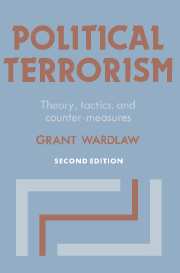Book contents
- Frontmatter
- Contents
- Preface to the second edition
- Preface to the first edition
- Part One An introduction to political terrorism
- 1 The problem of defining terrorism
- 2 Terrorism: a historical perspective
- 3 The changing nature of terrorism
- 4 The purpose of terrorism
- 5 The development of terrorism as a strategy
- 6 Trends in terrorism
- 7 The effects of terrorism
- Part Two Some selected problems in the response to terrorism
- Notes
- Select bibliography
- Index
5 - The development of terrorism as a strategy
Published online by Cambridge University Press: 05 January 2012
- Frontmatter
- Contents
- Preface to the second edition
- Preface to the first edition
- Part One An introduction to political terrorism
- 1 The problem of defining terrorism
- 2 Terrorism: a historical perspective
- 3 The changing nature of terrorism
- 4 The purpose of terrorism
- 5 The development of terrorism as a strategy
- 6 Trends in terrorism
- 7 The effects of terrorism
- Part Two Some selected problems in the response to terrorism
- Notes
- Select bibliography
- Index
Summary
It has been shown that the use of terror has a long history and is not, as many seem to believe, a novel phenomenon of the twentieth century. It can certainly be argued, however, that terrorism as a coherent philosophy and the kind of terrorism society faces today are unique, and certain modern variants trace their immediate antecedents to theories of revolutionary warfare developed primarily in this century. Perhaps the greatest guerrilla theorist was Mao Tse-tung who developed a coherent theory which integrated what were essentially a set of military tactics used by those who lacked armies. Mao deviated significantly from both the existing Marxist revolutionary theories and existing military strategy. In his famous slogan ‘political power grows out of the barrel of a gun’, Mao acknowledged the military basis of political power. However, he also knew that at the beginning of the struggle his forces would be numerically and technologically inferior and so emphasised the importance of political power as a substitute for military power. Thus, it was considered vital that the guerrillas be highly motivated politically so that, strengthened by the political support of the peasantry, they could survive early military reverses and have the determination to carry on a protracted campaign which would eventually wear down the less committed and dedicated opposition.
- Type
- Chapter
- Information
- Political TerrorismTheory, Tactics and Counter-Measures, pp. 43 - 49Publisher: Cambridge University PressPrint publication year: 1989



